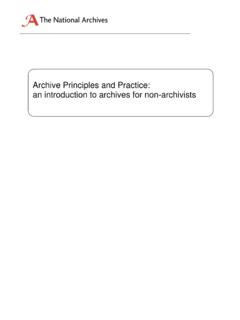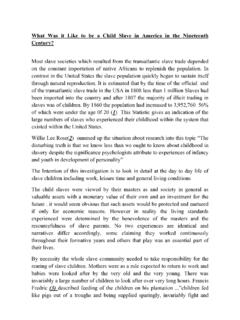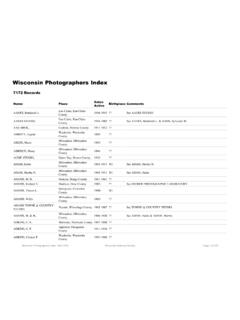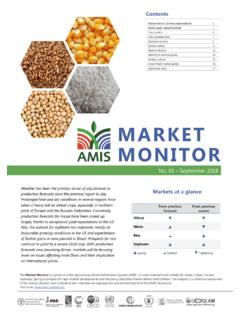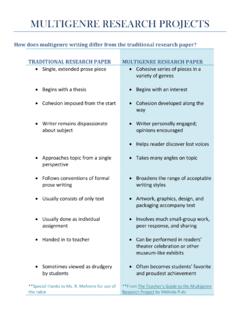Transcription of MOD Service Records Collection FAQs
1 The MOD Service Records Collection 1. What are the Service personnel Records ? Service Records are a record of an indvidual's time in the military. The Records that make up this Collection cover before, during and after individuals' Service in the Royal Navy, Army, and Royal Air Force, where the individual has a date of birth up to and including 1939. The Collection we are transferring from the Ministry of Defence captures the Service of almost 10 million individuals. They include Records of around 500,000 individuals with First World War Service and the vast majority of those who served in the Second World War, as well as those who did National Service . The Records cover British subjects from the UK and overseas as well as foreign nationals who served with British forces for example within the Aden Pioneer Corps and Libyan ArabForce. 2. When and why were they created?
2 Personnel Records are created when individuals sign up to the join the military and start their army career. This Collection dates back over 170 years to the Crimean War. 3. What information is in these Records ? The information in the Records typically consists of personal information relating to the individual and the interactions between the individual and the part of the armed forces they served with, such as Structured information captured when the individual joined up, usually on an attestation form. This is a form that Records detailed information about the soldier including name, age, address, height, hair and eye colour, previous jobs, and if they have been in prison Statement of services (B200 forms) - includes address, education, next of kin details (including children). Record of Service Disciplinary and conduct record sheets Medical reports details of injuries, medical assessments and treatments, dental information Service postings dates and places posted 4.
3 How are the personnel Records compiled and arranged? The Records are typically grouped by Service for example, Army Records . They are then broken down into various sub-categories although this varies across the Collection . All Records Page 1 of 7. The MOD Service Records Collection made available by The National Archives are described on our online catalogue, Discovery, the structure of which is informed by the original order of the Records . To provide context and make them easy to find, the Records are organised under different department codes, divisions and series within the catalogue. 5. What Records are being made accessible? The first Records we have been able to make available for public access are those in series WO420 and they cover The Royal Electrical and Mechanical Engineers regiment. The Records released today are those with a date of birth greater than 115 years and that can be ordered by members of the public.
4 We will release the rest of this series over the following days, for which additional access restrictions apply. 6. Why are they the only ones accessible at this point in time? In February 2021, the Ministry of Defence began the transfer of historic Service personnel Records to The National Archives. Records are regularly delivered to The National Archives. There are approximately million Records which will be transferred over the next 6 years. These are the first Records to be made available to the public. We will use them to learn the best way to make the Records available and implement those findings as we make more Records accessible. 7. When will the rest of the Records be available? The Records do require some work before being made available, depending on access restrictions, to the public. The National Archives will provide further advice on how and when these Records can be accessed in the coming months via our website and social media platforms.
5 8. Why is medical information closed for longer in this Collection when available in other transferred MOD Records ? Some of the Records within this vast Collection contain a wealth of medical information. Thus, a different closure period was required to manage the sensitivities and the expectation of confidence. The current approach for access to deceased Service personnel Records is found on pages. The ICO have also outlined within their guidance the case precedent regarding the applicability of the section 41 exemption for confidential information to requests for medical Records of deceased persons. Having applied the 100-year rule in order to determine a lifetime closure period (Section 40 exemption personal data) then when dealing with medical information that has an expectation of confidence lasting beyond death we needed to arrive at a period that comes sometime after the expiry of the 100 year closure.
6 Given that the duty of confidence does diminish over time, MOD and TNA felt that 115 years after date of birth was a balance between recognising the obligation to keep this information confidential, whilst providing access to a significant Collection of historical Records . 9. How can I open a record of an individual I know to be deceased? Whether or not the material can be opened, will be assessed upon request, and considered Page 2 of 7. The MOD Service Records Collection under relevant access legislation; Data Protection and Freedom of Information laws. To open a record, it must first be located and checked. For those Records relating to individuals born less than 100 years ago we will require provide proof of death, in order to consider if information can be released from the record. Suitable forms of evidence are an official death certificate or published obituary.
7 10. Will these Records be digitised? Yes. We are currently undertaking a procurement exercise to appoint a digitisation partner. 11. Why can't I find the person I am looking for? This release of Records on our catalogue is a small part of the Records from the million that compromises the Service personnel Collection . As part of this project and transfer we have received an index that contains the data from those individuals whose Records form part of this Collection . To help people access the Records and search the Records , we have created request forms which will be accessible both on website and within the Catalogue for closed Records . If you can't find the individual you are looking for within series WO 420, you can email our Access Service Team at where the team will search the database for your desired record. To establish if the individual you are looking for has a record within this Collection , we need as much information as possible to find a match/es For this we need The full name Date of birth Service number - if known In the absence of the Service number other useful information would be.
8 Place of birth Regiment It is possible that once we have searched the index we still can't find the record you are looking for. There are several reasons for this, but mainly, the record does not exist. A number of First World War Service personnel Records were destroyed during the Blitz in 1940 when the War Page 3 of 7. The MOD Service Records Collection Office warehouse that was housing them in Arnside Street was bombed. Although efforts were made to retrieve the Records , some were unfortunately unsalvageable. Alternatively it may be that the data within the index may not match the information provided, for example the spelling of the names may be slightly different; incorrectly transcribed. If you cannot find an exact match for the data you have used to search, it might be worth looking at several possible Records and trying a variety of possible spellings.
9 From within those Records on Discovery; if you do notice an error in a description, please make us aware so that we can check the record and amend where appropriate. You can do this by clicking on the Found an error?' link in our online catalogue, Discovery. This is displayed at the bottom of every catalogue entry. In cases where we get near matches, we may need to check several Records to find a match and determine if the record is held. If we need more information from you, we will request this from you. If we find a match, but the record is still held by MOD, we will also inform you of the result of the search and the next steps for your research. This project and transfer will take up to six years to complete and we do not have all the Records within this Collection . 12. Why are Records closed? These are personnel Records , of identified individuals and they contain a range of personal data including medical information.
10 Therefore closure will apply until 115 years past the date of birth of the individual. Information relating to living individuals is their personal data and will be withheld under section 40 of the Freedom of Information Act 2000. Any medical information regarding an individual will be considered exempt under section 41 . information provided in confidence. 13. How can I see my own record? An individual is entitled to submit a Data Subject Access Request to obtain their own record information within the Service Records we hold. These requests fall under the Data Protection Act 2018 and the UK General Data Protection Regulation. You can contact the Access Service Team via to request access to your own record, or the Records of someone who has given you permission to act on their behalf. You will need to provide proof of identification, and if on behalf of another, proof you have permission to act on their behalf, proof of their identification and proof of your identity.





